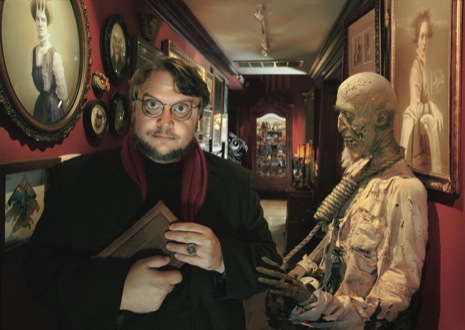
For a long time I have been interested in the influences on those who make great films and television, and how these influences are reflected in the art they produce. This is especially the case with those artists who embody their art, their art coming out as a result of the creative passions they live on a daily basis. Sometimes such artists can be considered eccentric, as in the case of Tim Burton, one of my favorite film directors. His ideas about art and film simply flow out of him and he does his work in the genre not primarily as a director paid to create a specific film to result in the best box office possible, but rather his cinematic art comes as a creative outflowing of who he is as a person.
I would also place another of my favorite film directors in this category, Guillermo del Toro, the brilliant dark fantasy and horror film director, and one not afraid to be identified completely and unabashedly with genre work. Recently The New Yorker ran an extensive piece on del Toro titled “Show the Monster” by Daniel Zalewski that sheds light not only on the director’s work, but also on some of the forces that drive his creative processes.
There are many interesting facets of the article, but for me the most interesting are the biographical elements it includes that provide a window into why del Toro takes on the projects he does, and why they look and feel the way they do. Like any artist del Toro brings some of his personal experiences to his craft, and as various media have noted from time to time, some of the most significant experiences for del Toro shaped his metaphysical views which in turn shape his art. I have commented on some of this in a previous post which noted aspects of del Toro’s story that were shared in an interview with National Public Radio:
A portion of the interview is heart-wrenching as del Toro describes growing up with a stern Catholic grandmother who saw his identification with monsters and fairy tales as somehow demonic. These experiences, coupled with his work in a morgue, the kidnapping of his father, and his reflections on the Spanish Civil War, all shaped his negative views of Catholicism and organized religion, so much so that in the interview he says he had to jettison the belief that there was an ordering Being beyond the universe and that as a result “we are all on our own.”
The New Yorker article echoes some of these elements, but adds another layer, including his understandably visceral reaction to seeing dead fetuses while working in a morgue:
Del Toro had been raised Catholic, but this sight, he said, upended his faith. Humans could not possibly have souls; even the most blameless lives ended as rotting garbage. He became a “raging atheist.” Guadalajara was a rough place, and he recalled his childhood as a slide show of harrowing images: the decapitated body of a teen-age boy, found by a barbed-wire fence; a crashed motorist aflame inside his VW Beetle.
It should come as no surprise then that del Toro’s religious and metaphysical views are reflected in his fantasy and horror, as well as his preferences in this area. Knowing some of his background I was actually more surprised to hear in the past that he was going to direct The Hobbit than I was to hear that he had later left the project. The Hobbit reflects Tolkien’s imaginative Catholicism, and with del Toro’s rejection of Catholicism, and his acknowledgment that he has never been a strong fan of this type of fantasy, it is more of wonder that he became connected to the project initially at all. However, he has said quite a bit in the media lately about one of his many projects that he is very excited about, and it is one which fits in better with his metaphysical views. It is a film version of H.P. Lovecraft’s novella “At the Mountains of Madness.” Lovecraft was an atheist, and his metaphysical views shaped his expressions of horror as well.
Various writers have noted that monsters and horror have been used to depict religious and irreligious fears. Guillermo del Toro’s atheism, shaped by life’s frequent violence and gruesomeness, is an important facet for auteur theory in understanding what makes this creative director tick as one of the best current filmmakers in dark fantasy and horror.
Incidentally, if anyone can connect me with del Toro, I’d love to discuss his use of myth and archetype, as well as the function of his metaphysical views in his fantasy and horror for a biography or PhD dissertation. Hey, a guy can dream.
Related posts:
“Pan’s Labyrinth: A Grand Fairy Tale and Key to the World of Wonder”
“Guillermo del Toro: Visionary Fantasy and Mythic Filmmaker”
“Lovecraft: Fear of the Unknown Documentary – Director Frank Woodward Interview





3 Responses to “Guillermo del Toro and Auteur Metaphysics”